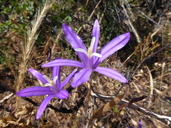Taxon Report
Brodiaea leptandra (Greene) Bakernarrow-anthered brodiaea |
 © 2018 Zoya Akulova |
Taxon Summary
Brodiaea leptandra, commonly known as narrow-anthered brodiaea, is a perennial bulbiferous herb in the Themidaceae that is found only in California. It occurs within Broadleafed upland forest, Chaparral, Cismontane woodland, Lower montane coniferous forest, and Valley and foothill grassland, growing at elevations from 110 to 915 meters. Brodiaea leptandra is ranked 1B.2, Plants Rare, Threatened or Endangered in California and Elsewhere; Moderately threatened in California.Classification
|
Scientific Name: |
Brodiaea leptandra (Greene) Baker |
|
Common Name: |
narrow-anthered brodiaea |
| Family: | Themidaceae |
| Element Code: | PMLIL0C022 |
| USDA Plants Symbol: | |
|
Synonyms/Other Names: |
|
Ecology and Life History
| Lifeform: | perennial bulbiferous herb |
| Blooming Period: May-Jul | May-Jul |
| Elevation: | 110-915 (360-3000) |
| General Habitats: | Broadleafed upland forest, Chaparral, Cismontane woodland, Lower montane coniferous forest, Valley and foothill grassland |
| Microhabitat: | Volcanic |
| Microhabitat Details: |
Conservation Status
| CA Rare Plant Rank: | 1B.2 |
| Global Rank: | G3? |
|
State Rank: |
S3? |
| State List: | None |
| Fed List: | None |
| Other Status: | SB_CalBG/RSABG |
|
CRPR Changes: |
|
Occurrence Data from the CNDDB
| Total Occurrences: | 39 |
| Element Occurrence Ranks: | |
| Excellent (A) | 4 |
| Good (B) | 8 |
| Fair (C) | 1 |
| Poor (D) | 0 |
| None (X) | 1 |
| Unknown (U) | 25 |
| California Endemic: True | |
| California Counties and Islands: Name (Code) | |
| Lake (LAK), Napa (NAP), Sonoma (SON) | |
| Quads: Name (Quad Code) | |
| Calistoga (3812255), Capell Valley (3812242), Chiles Valley (3812253), Detert Reservoir (3812265), Geyserville (3812268), Healdsburg (3812257), Kenwood (3812245), Mark West Springs (3812256), Mount St. Helena (3812266), Mt. George (3812232), Napa (3812233), Rutherford (3812244), Santa Rosa (3812246), Sonoma (3812234), St. Helena (3812254), Yountville (3812243) | |
Threat List Data from the CNDDB
| Threat List Total: | 9 | |
| EOs with Threat Listed: | Total EOs | % of EOs |
| 11 | 28 % | |
| Road/trail construction/maint. | 5 | 12% |
| Development | 4 | 10% |
| Agriculture | 2 | 5% |
| Surface water diversion | 1 | 2% |
| Wood cutting or brush clearing | 1 | 2% |
| Foot traffic/trampling | 1 | 2% |
| Improper burning regime | 1 | 2% |
| Non-native plant impacts | 1 | 2% |
| Over-collecting/poaching | 1 | 2% |
Notes
| Threatened by development, foot traffic, and horticultural collecting. Possibly threatened by road maintenance and non-native plants. See Pittonia 1:74 (1887) for original description, American Midland Naturalist 22:570 (1939) for revised nomenclature, and University of California Publications in Botany 60:40 (1971) for taxonomic treatment. |
|
Threats: |
|
Taxonomy: |
Citation
California Native Plant Society, Rare Plant Program. 2025. Rare Plant Inventory (online edition, v9.5.1). Website https://www.rareplants.cnps.org [accessed 14 December 2025].